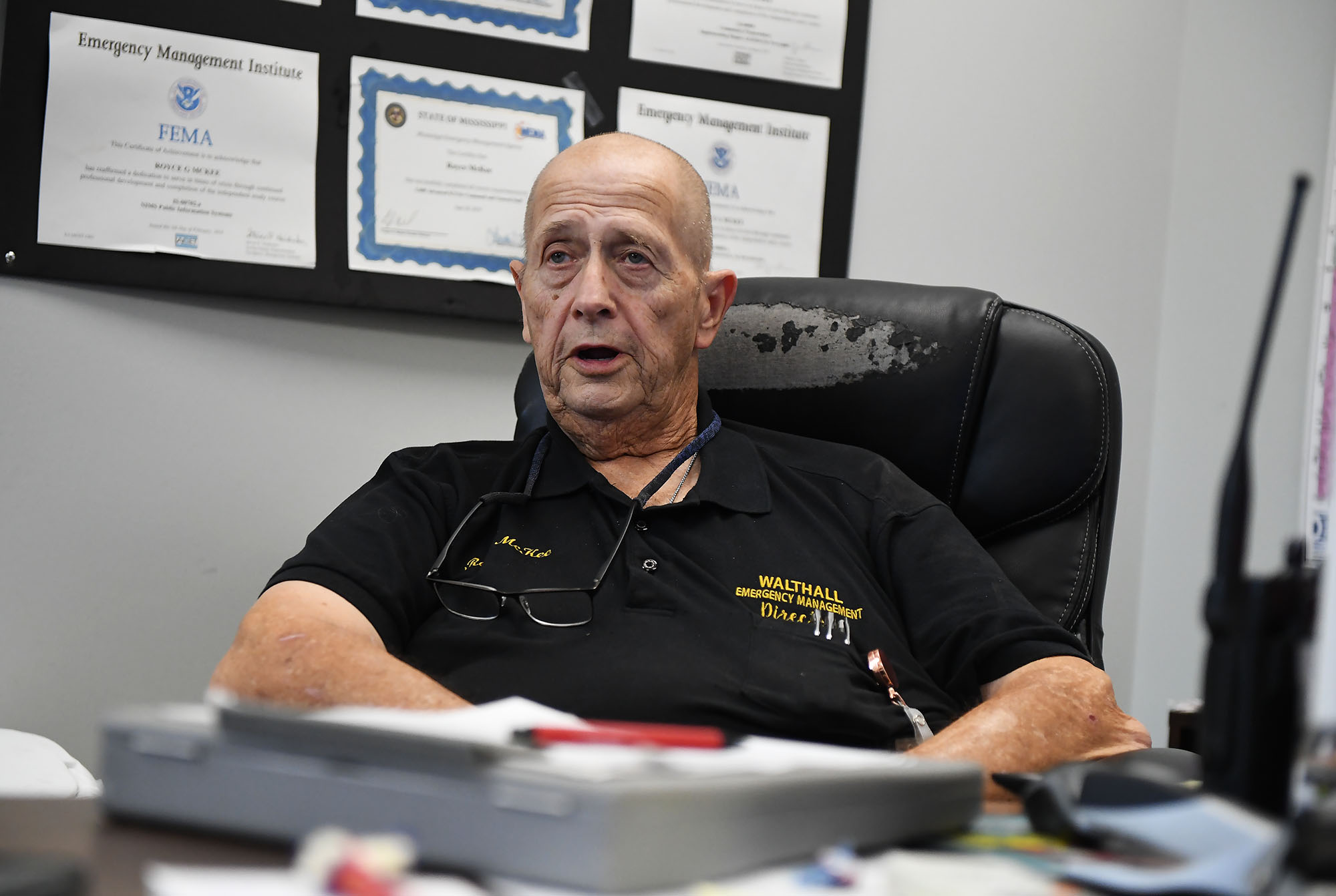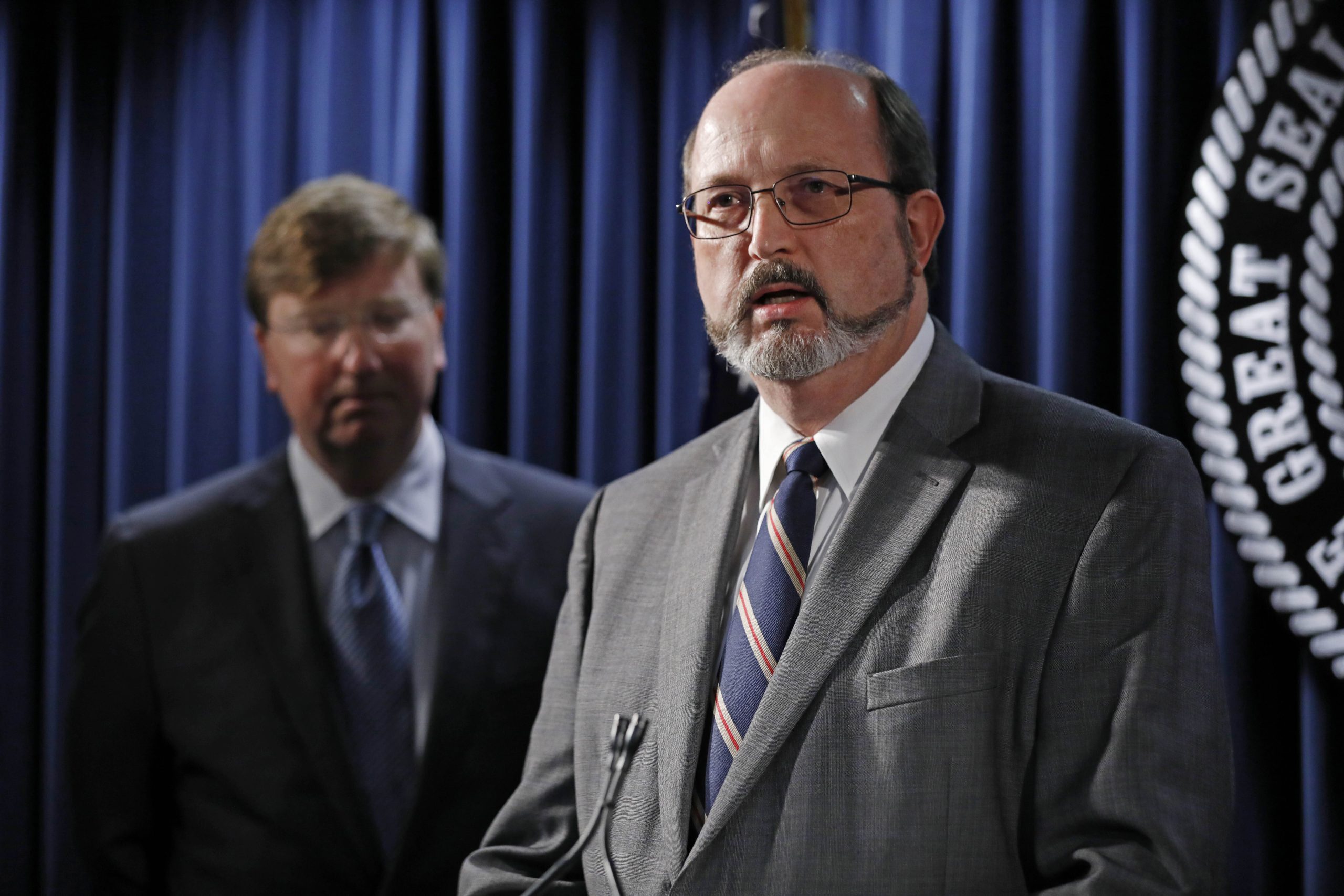Mississippi Today
State leaders still won’t fix scandalous welfare program that serves few poor families
State leaders still won’t fix scandalous welfare program that serves few poor families
Now that Mississippi’s welfare department isn’t hemorrhaging federal grant funds as a result of widespread mismanagement and political corruption, it has over $100 million to spare.
But the agency, Mississippi Department of Human Services, won’t say what it’s going to do with the money; whether it’s going to try to reach more needy families; or how it’s going to finally start tracking outcomes of the program.
In the three years following arrests in the largest public fraud scandal in state history, the agency led by Gov. Tate Reeves has never released a full accounting of its current welfare expenditures. There isn’t even a list of organizations receiving the funding on the agency’s website, nor are its subgrant agreements available online.
And lawmakers, in their seventh week of the Legislative session, haven’t taken one action to address the logjam. Instead, they’ve killed at least 11 bills aimed at improving the administration of the agency and its funds, as well as at least five amendments offered to do the same on the floors of both chambers.
All the bills filed to address these problems were killed by Republican committee chairs without debate, and all the amendments were introduced by Democrats and voted down by Republicans, primarily along party lines.
“(Mississippi Department of Human Services) has certainly not held up to its mission or its responsibility to those who need it the most,” said Rep. Omeria Scott, D-Jones, who offered an amendment to the MDHS appropriations bill on Wednesday to make increases to the agency’s budget, which Republicans reduced. “I do hate that through the general bills process that there was no legislation for a board, or no legislation for any of these audits that are in this appropriations bill, that we got any reports or any demands or anything like that. That has not been before us, and I imagine won’t be before us, but let me say to you that there are areas over there in Human Services that need some escalation.”
While Republican leadership says it has cleaned up fraud within the agency, that doesn’t mean the welfare program, called Temporary Assistance for Needy Families, is reaching the needy or helping people enter the workforce. In fact, during the height of the scandal, the state was using more of its TANF funds to help more poor Mississippians than it is today.
In 2022, a monthly average of 246 adults and 2,265 children benefited from the welfare check — no more than $260 for a family of three (a rate that was raised in 2021 for the first time since 1999). Mississippi is consistently among the most impoverished states in the nation with 1-in-5 of its residents living below the poverty line. The assistance is reaching about 4% of the more than half-a-million Mississippians living in poverty.
Meanwhile, the state continues to rack up tens of millions in welfare funds. By October of 2021, more than a year ago, Mississippi’s TANF program had amassed $97.9 million in unobligated funds. While the agency hasn’t released data showing how they spent the money within the last year, all indications are that the number of unspent TANF funds has only grown, especially since the state didn’t issue a single new TANF subgrant in 2022.
In October, MDHS Director Bob Anderson hesitated to say how his agency might spend the money, or whether it would use the funds to, for example, increase the number of child care vouchers it is able to provide to low-income families.
“Understand, people have a lot of other plans for that money as well,” Anderson said.
MDHS has refused to answer Mississippi Today’s questions about which people and what plans.
The sections of the TANF program that have received most public attention are:
- Cash assistance — the money that goes out directly to families who qualify for the welfare check
- Subgrants — the money that goes to organizations to provide TANF-related services, such as after school programs, parenting classes and workforce training
But these currently account for less than half of the state’s annual federal TANF grant.
And according to the state’s checkbook, the state spends millions of TANF funds each year on items outside of cash assistance or TANF subgrants — such as IT contracts, a contract with the company who conducts drug testing of welfare applicants, interagency transfers to the state auditor’s office or payments to the attorneys crafting the civil case against NFL legend Brett Favre and others. There has not been a public accounting of these purchases, nor have they been discussed in audits, legislative hearings or among lawmakers publicly.
Each year, the state also transfers a large chunk of TANF funds, the amount unknown to the public, to Mississippi Child Protection Services, the embattled state agency responsible for investigating child abuse and neglect and overseeing foster care across the state. The financial maneuver is preventing the state from taking advantage of unprecedented federal matching funds offered under the 2018 Family First Prevention Services Act to help families stay intact.
Aside from the scandalous stories about politicians and famous athletes funneling TANF money to their pet projects during former Gov. Phil Bryant’s administration, the welfare program itself is as forgotten and ignored as it was before the arrests.
Lawmakers passed a bill in 2021 to place law enforcement officers within MDHS’s Fraud Investigation Unit and a bill in 2022 to require that employees of the unit report civil or criminal violations to the state auditor’s office.
Neither of these changed how the agency runs its TANF grant or introduced any accountability for the agency to spend the money effectively.
In 2021, the first full year after the scandal was revealed, Mississippi spent just $35.6 million of the $86.5 million it receives in federal funds each year, according to federal reports released in December. The reports are typically outdated by about a year.
To put that into perspective: In 2018, Mississippi spent about $113 million in federal TANF funds (including some unspent funds from years before). If $50 million of that went to fraudulent or unallowed purchases, that leaves $63 million that Mississippi spent legally that year, including to organizations similar to those providing services today.
In 2018, at the height of the fraud scandal, the state pumped $7.3 million directly to families, whereas it only gave $3.5 million in cash assistance in 2021. Either way you slice it, Mississippi’s welfare department was using more TANF money to help more poor Mississippians during the years of Bryant’s appointed former MDHS Director John Davis, who is likely going to prison, than the agency is today under Reeves and Anderson.
Mississippi Department of Human Services previously told the public that it is allocating about $69 million of its TANF funds each year — $4.1 million on cash assistance, $34.5 million on subgrants to organizations and $30 million to plug budget holes at the Mississippi Department of Child Protection Services.
But it has not made documentation of these expenditures available to the public. Also, these figures are not clearly reflected in federal reports. In 2021, for example, the state only reported spending $15 million in TANF funds on “child welfare” – the only spending category that would appear to correspond with the CPS transfers.
The agency would not explain the reason for the discrepancies in the federal reporting, other than to say that it’s possible not all of the money that the state obligated was actually used. The department has also repeatedly failed to explain which purchases fall under which categories in the federal reports.
The state is allowed to use grant funds from one year to another for a period of three years. So funds being spent today could technically be coming from the state’s 2021 TANF grant. That, and the fact that some subgrants span more than one year, during which the subgrantee can draw the funds at their leisure, have perpetually created a foggy picture of the program.
The only documentation of TANF expenditures that MDHS appears to have made public, at the request of Mississippi Today, is a list of subgrantees to whom the state awards a fraction of the funds. This information does not appear on the agency’s website, nor in its annual report.
In mid-2020, the department provided to Mississippi Today a spreadsheet of TANF purchases that included, in addition to payments to subgrantees, expenditures for things like tech support or hotels for employee training. In October, Mississippi Today extracted and analyzed all purchases labeled under the TANF program from the state’s accounting database from 2015 to 2022, all of which Mississippi Today made publicly available, but the expenditures didn’t add up to nearly the amount the state reported spending to the federal government. Transfers from MDHS to CPS also do not appear on the state’s accounting database.
The department began the most recent Request for Proposals — a competitive bid process — for TANF subgrants in June of 2022. But due to staff changes within MDHS’s Division of Workforce Development and Partnership Management, a spokesperson said, the agency has not made an award.
“Once we have a finalized plan we will make a public announcement,” MDHS Chief Communication Officer Mark Jones offered in response to questions about the agency’s plan for the TANF program moving forward.
Even with the grants most recently awarded in 2021, it’s unclear what all of the organizations are accomplishing or how the programs align with a vision to reduce poverty. The current grants cover parenting initiatives ($8.1 million), after school programs ($13.7 million), and workforce development ($14.9 million). The subgrant agreements aren’t even available on Mississippi’s transparency website.
The largest award was a $6.9 million parenting initiative grant to Mississippi Children’s Home Society, or Canopy Solutions, a children’s behavioral health services provider, including a residential psychiatric facility. Canopy has been a TANF subgrantee for years and works within the foster care system to prevent family separations. Canopy also recently launched a specialized nonprofit school for students with learning differences in Ridgeland, essentially replacing the recently shuttered New Summit School by hiring its employees and recruiting its students.
New Summit closed after its founder Nancy New was charged within the welfare scandal. New was funneling TANF money to New Summit, a for-profit school, and also running a separate scam to defraud the Mississippi Department of Education, she admitted in her 2022 guilty pleas.
Other current TANF subgrantees include the Mississippi Alliance of Boys and Girls Clubs ($5.3 million), Save the Children Federation ($2.4 million), YMCA Metro Jackson ($1 million), and Juanita Sims Doty Foundation ($1 million) for afterschool programs; and Institutions of Higher Learning ($2.4 million), Mississippi Department of Employment Security ($1.5 million), South Delta Planning and Development District ($2.1 million), Southern MS Planning and Development District Gulfport ($3.6 million), Three Rivers Planning & Development District ($4.7 million) for workforce training.
Since welfare reform in the late 1990s, state leaders, workforce specialists, industry experts and advocates have met, studied, and discussed ad nauseam the barriers they’ve identified for families escaping poverty – chief among them child care, transportation and workforce training that aligns with market needs. The concept of TANF when Congress created it was to move people into the workforce, hopefully ending the reliance on government assistance.
Mississippi could be transferring up to 30% of its TANF funding to supplement the Child Care Development Block Grant, which provides child care vouchers to low-income working parents. The program has always served just a small fraction of low-income children needing child care across the state.
While legislation is not required for MDHS to make this transfer – since it has done so in the past, according to federal reports – the current Legislature has killed bills and amendments to compel MDHS to use TANF funds this way. And the agency refuses to answer questions about whether it will or, if not, why it won’t. The agency has, however, complained that without a budget supplement, 12,000 kids may be kicked off the voucher.
“From the beginning of the (TANF) program, there have been thoughts like, ‘We need to figure out a way to provide daycare. We need to figure out a way to provide transportation and that will help get a large number of people back into the workforce,’ which is said to be the aim of all these reforms,” Senate Public Health Committee Chair Hob Bryan, D-Amory, said during a floor debate on several TANF-related amendments last week. “And it is extremely frustrating that we have money that could be used for additional vouchers for childcare, so that there would be someone to care for children when their parent is at work and we’re not taking advantage of that. And yet we complain about people not working.”
This article first appeared on Mississippi Today and is republished here under a Creative Commons license.
Mississippi Today
Mississippi prepares for another execution
The Mississippi Supreme Court has set the execution of a man who kidnapped and murdered a 20-year-old community college student in north Mississippi 30 years ago.
Charles Ray Crawford, 59, is set to be executed Oct. 15 at the Mississippi State Penitentiary at Parchman, after multiple requests by the attorney general’s office.
Eight justices joined the majority opinion to set the execution, concluding that Crawford has exhausted all state and federal legal remedies. Mississippi Supreme Court Justice T. Kenneth Griffis Jr. wrote the Friday opinion. Justice David Sullivan did not participate.
However, Kristy Noble with the Mississippi Office of Capital Post-Conviction Counsel released a statement saying it will file another appeal with the U.S. Supreme Court.
“”Mr. Crawford’s inexperienced trial counsel conceded his guilt to the jury — against Mr.
Crawford’s timely and repeated objections,” Noble said in the statement. “Mr. Crawford told his counsel to pursue a not guilty verdict. Counsel did just the opposite, which is precisely what the U.S. Supreme Court says counsel cannot do,” Noble said in the statement.
“A trial like Mr. Crawford’s – one where counsel concedes guilt over his client’s express wishes – is essentially no trial at all.”
Last fall, Crawford’s attorneys asked the court not to set an execution date because he hadn’t exhausted appeal efforts in federal court to challenge a rape conviction that is not tied to his death sentence. In June, the U.S. Supreme Court declined to take up Crawford’s case.
A similar delay occurred a decade ago, when the AG’s office asked the court to reset Crawford’s execution date, but that was denied because efforts to appeal his unrelated rape conviction were still pending.
After each unsuccessful filing, the attorney general’s office asked the Mississippi Supreme Court to set Crawford’s execution date.
On Friday, the court also denied Crawford’s third petition for post-conviction relief and a request for oral argument. It accepted the state’s motion to dismiss the petition. Seven justices concurred and Justice Leslie King concurred in result only. Again, Justice Sullivan did not participate.
Crawford was convicted and sentenced to death in Lafayette County for the 1993 rape and murder of North Mississippi Community College student Kristy Ray.
Days before he was set to go to trial on separate aggravated assault and rape charges, he kidnapped Ray from her parents’ Tippah County home, leaving ransom notes. Crawford took Ray to an abandoned barn where he stabbed her, and his DNA was found on her, indicating he sexually assaulted her, according to court records.
Crawford told police he had blackouts and only remembered parts of the crime, but not killing Ray. Later he admitted “he must of killed her” and led police to Ray’s body, according to court records.
At his 1994 trial he presented an insanity defense, including that he suffered from psychogenic amnesia – periods of time lapse without memory. Medical experts who provided rebuttal testimony said Crawford didn’t have psychogenic amnesia and didn’t show evidence of bipolar illness.
The last person executed in Mississippi was Richard Jordan in June, previously the state’s oldest and longest serving person on death row.
There are 36 people on death row, according to records from the Mississippi Department of Corrections.
Update 9/15/25: This story has been updated to include a response from the Mississippi Office of Capital Post-Conviction Counsel
This article first appeared on Mississippi Today and is republished here under a Creative Commons Attribution-NoDerivatives 4.0 International License.
The post Mississippi prepares for another execution appeared first on mississippitoday.org
Note: The following A.I. based commentary is not part of the original article, reproduced above, but is offered in the hopes that it will promote greater media literacy and critical thinking, by making any potential bias more visible to the reader –Staff Editor.
Political Bias Rating: Centrist
The article presents a factual and balanced account of the legal proceedings surrounding a scheduled execution in Mississippi. It includes perspectives from both the state’s attorney general’s office and the defense counsel, without using emotionally charged language or advocating for a particular political stance. The focus on legal details and court decisions reflects a neutral, informative approach typical of centrist reporting.
Mississippi Today
Presidents are taking longer to declare major natural disasters. For some, the wait is agonizing
TYLERTOWN — As an ominous storm approached Buddy Anthony’s one-story brick home, he took shelter in his new Ford F-250 pickup parked under a nearby carport.
Seconds later, a tornado tore apart Anthony’s home and damaged the truck while lifting it partly in the air. Anthony emerged unhurt. But he had to replace his vehicle with a used truck that became his home while waiting for President Donald Trump to issue a major disaster declaration so that federal money would be freed for individuals reeling from loss. That took weeks.
“You wake up in the truck and look out the windshield and see nothing. That’s hard. That’s hard to swallow,” Anthony said.
Disaster survivors are having to wait longer to get aid from the federal government, according to a new Associated Press analysis of decades of data. On average, it took less than two weeks for a governor’s request for a presidential disaster declaration to be granted in the 1990s and early 2000s. That rose to about three weeks during the past decade under presidents from both major parties. It’s taking more than a month, on average, during Trump’s current term, the AP found.
The delays mean individuals must wait to receive federal aid for daily living expenses, temporary lodging and home repairs. Delays in disaster declarations also can hamper recovery efforts by local officials uncertain whether they will receive federal reimbursement for cleaning up debris and rebuilding infrastructure. The AP collaborated with Mississippi Today and Mississippi Free Press on the effects of these delays for this report.
“The message that I get in the delay, particularly for the individual assistance, is that the federal government has turned its back on its own people,” said Bob Griffin, dean of the College of Emergency Preparedness, Homeland Security and Cybersecurity at the University at Albany in New York. “It’s a fundamental shift in the position of this country.”
The wait for disaster aid has grown as Trump remakes government
The Federal Emergency Management Agency often consults immediately with communities to coordinate their initial disaster response. But direct payments to individuals, nonprofits and local governments must wait for a major disaster declaration from the president, who first must receive a request from a state, territory or tribe. Major disaster declarations are intended only for the most damaging events that are beyond the resources of states and local governments.
Trump has approved more than two dozen major disaster declarations since taking office in January, with an average wait of almost 34 days after a request. That ranged from a one-day turnaround after July’s deadly flash flooding in Texas to a 67-day wait after a request for aid because of a Michigan ice storm. The average wait is up from a 24-day delay during his first term and is nearly four times as long as the average for former Republican President George H.W. Bush, whose term from 1989-1993 coincided with the implementation of a new federal law setting parameters for disaster determinations.
The delays have grown over time, regardless of the party in power. Former Democratic President Joe Biden, in his last year in office, averaged 26 days to declare major disasters — longer than any year under former Democratic President Barack Obama.

FEMA did not respond to the AP’s questions about what factors are contributing to the trend.
Others familiar with FEMA noted that its process for assessing and documenting natural disasters has become more complex over time. Disasters have also become more frequent and intense because of climate change, which is mostly caused by the burning of fuels such as gas, coal and oil.
The wait for disaster declarations has spiked as Trump’s administration undertakes an ambitious makeover of the federal government that has shed thousands of workers and reexamined the role of FEMA. A recently published letter from current and former FEMA employees warned the cuts could become debilitating if faced with a large-enough disaster. The letter also lamented that the Trump administration has stopped maintaining or removed long-term planning tools focused on extreme weather and disasters.
Shortly after taking office, Trump floated the idea of “getting rid” of FEMA, asserting: “It’s very bureaucratic, and it’s very slow.”
FEMA’s acting chief suggested more recently that states should shoulder more responsibility for disaster recovery, though FEMA thus far has continued to cover three-fourths of the costs of public assistance to local governments, as required under federal law. FEMA pays the full cost of its individual assistance.
Former FEMA Administrator Pete Gaynor, who served during Trump’s first term, said the delay in issuing major disaster declarations likely is related to a renewed focus on making sure the federal government isn’t paying for things state and local governments could handle.
“I think they’re probably giving those requests more scrutiny,” Gaynor said. “And I think it’s probably the right thing to do, because I think the (disaster) declaration process has become the ‘easy button’ for states.”
The Associated Press on Monday received a statement from White House spokeswoman Abigail Jackson in response to a question about why it is taking longer to issue major natural disaster declarations:
“President Trump provides a more thorough review of disaster declaration requests than any Administration has before him. Gone are the days of rubber stamping FEMA recommendations – that’s not a bug, that’s a feature. Under prior Administrations, FEMA’s outsized role created a bloated bureaucracy that disincentivized state investment in their own resilience. President Trump is committed to right-sizing the Federal government while empowering state and local governments by enabling them to better understand, plan for, and ultimately address the needs of their citizens. The Trump Administration has expeditiously provided assistance to disasters while ensuring taxpayer dollars are spent wisely to supplement state actions, not replace them.”

In Mississippi, frustration festered during wait for aid
The tornado that struck Anthony’s home in rural Tylertown on March 15 packed winds up to 140 mph. It was part of a powerful system that wrecked homes, businesses and lives across multiple states.
Mississippi’s governor requested a federal disaster declaration on April 1. Trump granted that request 50 days later, on May 21, while approving aid for both individuals and public entities.
On that same day, Trump also approved eight other major disaster declarations for storms, floods or fires in seven other states. In most cases, more than a month had passed since the request and about two months since the date of those disasters.
If a presidential declaration and federal money had come sooner, Anthony said he wouldn’t have needed to spend weeks sleeping in a truck before he could afford to rent the trailer where he is now living. His house was uninsured, Anthony said, and FEMA eventually gave him $30,000.
In nearby Jayess in Lawrence County, Dana Grimes had insurance but not enough to cover the full value of her damaged home. After the eventual federal declaration, Grimes said FEMA provided about $750 for emergency expenses, but she is now waiting for the agency to determine whether she can receive more.

“We couldn’t figure out why the president took so long to help people in this country,” Grimes said. “I just want to tie up strings and move on. But FEMA — I’m still fooling with FEMA.”
Jonathan Young said he gave up on applying for FEMA aid after the Tylertown tornado killed his 7-year-old son and destroyed their home. The process seemed too difficult, and federal officials wanted paperwork he didn’t have, Young said. He made ends meet by working for those cleaning up from the storm.
“It’s a therapy for me,” Young said, “to pick up the debris that took my son away from me.”
Historically, presidential disaster declarations containing individual assistance have been approved more quickly than those providing assistance only to public entities, according to the AP’s analysis. That remains the case under Trump, though declarations for both types are taking longer.
About half the major disaster declarations approved by Trump this year have included individual assistance.
Some people whose homes are damaged turn to shelters hosted by churches or local nonprofit organizations in the initial chaotic days after a disaster. Others stay with friends or family or go to a hotel, if they can afford it.
But some insist on staying in damaged homes, even if they are unsafe, said Chris Smith, who administered FEMA’s individual assistance division under three presidents from 2015-2022. If homes aren’t repaired properly, mold can grow, compounding the recovery challenges.

That’s why it’s critical for FEMA’s individual assistance to get approved quickly — ideally, within two weeks of a disaster, said Smith, who’s now a disaster consultant for governments and companies.
“You want to keep the people where they are living. You want to ensure those communities are going to continue to be viable and recover,” Smith said. “And the earlier that individual assistance can be delivered … the earlier recovery can start.”
In the periods waiting for declarations, the pressure falls on local officials and volunteers to care for victims and distribute supplies.
In Walthall County, where Tylertown is, insurance agent Les Lampton remembered watching the weather news as the first tornado missed his house by just an eighth of a mile. Lampton, who moonlights as a volunteer firefighter, navigated the collapsed trees in his yard and jumped into action. About 45 minutes later, the second tornado hit just a mile away.
“It was just chaos from there on out,” Lampton said.
Walthall County, with a population of about 14,000, hasn’t had a working tornado siren in about 30 years, Lampton said. He added there isn’t a public safe room in the area, although a lot of residents have ones in their home.
Rural areas with limited resources are hit hard by delays in receiving funds through FEMA’s public assistance program, which, unlike individual assistance, only reimburses local entities after their bills are paid. Long waits can stoke uncertainty and lead cost-conscious local officials to pause or scale-back their recovery efforts.

In Walthall County, officials initially spent about $700,000 cleaning up debris, then suspended the cleanup for more than a month because they couldn’t afford to spend more without assurance they would receive federal reimbursement, said county emergency manager Royce McKee. Meanwhile, rubble from splintered trees and shattered homes remained piled along the roadside, creating unsafe obstacles for motorists and habitat for snakes and rodents.
When it received the federal declaration, Walthall County took out a multimillion-dollar loan to pay contractors to resume the cleanup.
“We’re going to pay interest and pay that money back until FEMA pays us,” said Byran Martin, an elected county supervisor. “We’re hopeful that we’ll get some money by the first of the year, but people are telling us that it could be [longer].”
Lampton, who took after his father when he joined the volunteer firefighters 40 years ago, lauded the support of outside groups such as Cajun Navy, Eight Days of Hope, Samaritan’s Purse and others. That’s not to mention the neighbors who brought their own skid steers and power saws to help clear trees and other debris, he added.
“That’s the only thing that got us through this storm, neighbors helping neighbors,” Lampton said. “If we waited on the government, we were going to be in bad shape.”
Lieb reported from Jefferson City, Missouri, and Wildeman from Hartford, Connecticut.
Update 98/25: This story has been updated to include a White House statement released after publication.
This article first appeared on Mississippi Today and is republished here under a Creative Commons Attribution-NoDerivatives 4.0 International License.
The post Presidents are taking longer to declare major natural disasters. For some, the wait is agonizing appeared first on mississippitoday.org
Note: The following A.I. based commentary is not part of the original article, reproduced above, but is offered in the hopes that it will promote greater media literacy and critical thinking, by making any potential bias more visible to the reader –Staff Editor.
Political Bias Rating: Center-Left
This article presents a critical view of the Trump administration’s handling of disaster declarations, highlighting delays and their negative impacts on affected individuals and communities. It emphasizes concerns about government downsizing and reduced federal support, themes often associated with center-left perspectives that favor robust government intervention and social safety nets. However, it also includes statements from Trump administration officials defending their approach, providing some balance. Overall, the tone and framing lean slightly left of center without being overtly partisan.
Mississippi Today
Northeast Mississippi speaker and worm farmer played key role in Coast recovery after Hurricane Katrina
The 20th anniversary of Hurricane Katrina slamming the Mississippi Gulf Coast has come and gone, rightfully garnering considerable media attention.
But still undercovered in the 20th anniversary saga of the storm that made landfall on Aug. 29, 2005, and caused unprecedented destruction is the role that a worm farmer from northeast Mississippi played in helping to revitalize the Coast.
House Speaker Billy McCoy, who died in 2019, was a worm farmer from the Prentiss, not Alcorn County, side of Rienzi — about as far away from the Gulf Coast as one could be in Mississippi.
McCoy grew other crops, but a staple of his operations was worm farming.
Early after the storm, the House speaker made a point of touring the Coast and visiting as many of the House members who lived on the Coast as he could to check on them.
But it was his action in the forum he loved the most — the Mississippi House — that is credited with being key to the Coast’s recovery.
Gov. Haley Barbour had called a special session about a month after the storm to take up multiple issues related to Katrina and the Gulf Coast’s survival and revitalization. The issue that received the most attention was Barbour’s proposal to remove the requirement that the casinos on the Coast be floating in the Mississippi Sound.
Katrina wreaked havoc on the floating casinos, and many operators said they would not rebuild if their casinos had to be in the Gulf waters. That was a crucial issue since the casinos were a major economic engine on the Coast, employing an estimated 30,000 in direct and indirect jobs.
It is difficult to fathom now the controversy surrounding Barbour’s proposal to allow the casinos to locate on land next to the water. Mississippi’s casino industry that was birthed with the early 1990s legislation was still new and controversial.
Various religious groups and others had continued to fight and oppose the casino industry and had made opposition to the expansion of gambling a priority.
Opposition to casinos and expansion of casinos was believed to be especially strong in rural areas, like those found in McCoy’s beloved northeast Mississippi. It was many of those rural areas that were the homes to rural white Democrats — now all but extinct in the Legislature but at the time still a force in the House.
So, voting in favor of casino expansion had the potential of being costly for what was McCoy’s base of power: the rural white Democrats.
Couple that with the fact that the Democratic-controlled House had been at odds with the Republican Barbour on multiple issues ranging from education funding to health care since Barbour was inaugurated in January 2004.
Barbour set records for the number of special sessions called by the governor. Those special sessions often were called to try to force the Democratic-controlled House to pass legislation it killed during the regular session.
The September 2005 special session was Barbour’s fifth of the year. For context, current Gov. Tate Reeves has called four in his nearly six years as governor.
There was little reason to expect McCoy to do Barbour’s bidding and lead the effort in the Legislature to pass his most controversial proposal: expanding casino gambling.
But when Barbour ally Lt. Gov. Amy Tuck, who presided over the Senate, refused to take up the controversial bill, Barbour was forced to turn to McCoy.
The former governor wrote about the circumstances in an essay he penned on the 20th anniversary of Hurricane Katrina for Mississippi Today Ideas.
“The Senate leadership, all Republicans, did not want to go first in passing the onshore casino law,” Barbour wrote. “So, I had to ask Speaker McCoy to allow it to come to the House floor and pass. He realized he should put the Coast and the state’s interests first. He did so, and the bill passed 61-53, with McCoy voting no.
“I will always admire Speaker McCoy, often my nemesis, for his integrity in putting the state first.”
Incidentally, former Rep. Bill Miles of Fulton, also in northeast Mississippi, was tasked by McCoy with counting, not whipping votes, to see if there was enough support in the House to pass the proposal. Not soon before the key vote, Miles said years later, he went to McCoy and told him there were more than enough votes to pass the legislation so he was voting no and broached the idea of the speaker also voting no.
It is likely that McCoy would have voted for the bill if his vote was needed.
Despite his no vote, the Biloxi Sun Herald newspaper ran a large photo of McCoy and hailed the Rienzi worm farmer as a hero for the Mississippi Gulf Coast.
This article first appeared on Mississippi Today and is republished here under a Creative Commons Attribution-NoDerivatives 4.0 International License.
The post Northeast Mississippi speaker and worm farmer played key role in Coast recovery after Hurricane Katrina appeared first on mississippitoday.org
Note: The following A.I. based commentary is not part of the original article, reproduced above, but is offered in the hopes that it will promote greater media literacy and critical thinking, by making any potential bias more visible to the reader –Staff Editor.
Political Bias Rating: Centrist
The article presents a factual and balanced account of the political dynamics surrounding Hurricane Katrina recovery efforts in Mississippi, focusing on bipartisan cooperation between Democratic and Republican leaders. It highlights the complexities of legislative decisions without overtly favoring one party or ideology, reflecting a neutral and informative tone typical of centrist reporting.
-
Local News7 days ago
Russian drone incursion in Poland prompts NATO leaders to take stock of bigger threats
-
News from the South - North Carolina News Feed6 days ago
What we know about Charlie Kirk shooting suspect, how he was caught
-
News from the South - North Carolina News Feed6 days ago
Federal hate crime charge sought in Charlotte stabbing | North Carolina
-
Our Mississippi Home5 days ago
Screech Owls – Small but Cute
-
News from the South - Arkansas News Feed6 days ago
NW Arkansas Championship expected to bring money to Rogers
-
News from the South - North Carolina News Feed6 days ago
Under pressure, some immigrants are leaving American dreams behind
-
News from the South - Alabama News Feed7 days ago
Huntsville Fire & Rescue Holds 9/11 Memorial Service | Sept. 11, 2025 | News 19 at 5 p.m.
-
Mississippi News Video6 days ago
Mississippi Science Fest showcases STEAM events, activities












































